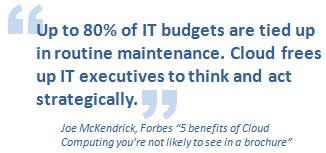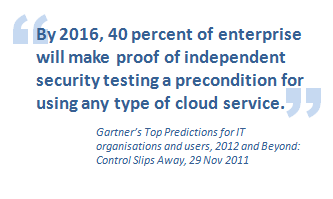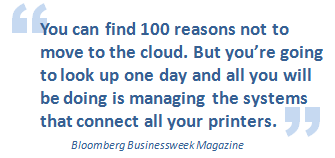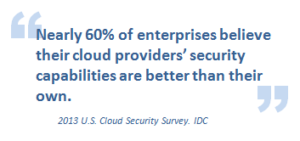What IT Leaders Need to Know about the Cloud
Aug 07 2014
A tsunami is coming. IT Leaders in the supply chain are facing one of the most profound shifts in decades with the emergence of the cloud. The appeal to business of being able to access scalable, best-practice services on-tap is irresistible, so the key for IT will be in successfully managing the transition. In this article, we share some of the real benefits, but also some key considerations for moving to the cloud.
The move to cloud is inevitable and the signs are manifest: Sales at Amazon Web Services (by far the biggest cloud provider) are nearing $5 Billion annually. Other major players are focusing on catching them – IBM reportedly recently laid off 25% of its existing hardware workforce to re-employ in the cloud sector and Microsoft’s cloud infrastructure provider, Azure, has reported outstanding growth figures.
It’s a rare organisation which doesn’t already have some business functions in the cloud – most businesses use at least cloud-based communications services, HR or finance services. IT organisations are up-skilling rapidly to meet this changing landscape. However, as the time approaches to consider when and how to transition mission-critical and highly complex ERP systems to the cloud, we believe that the wise IT leader will step back and start formulating a serious transition plan for moving to the cloud in the next 3-7 years and be thinking about the impact that this landscape will have on the role of IT, and preparing the organisation.
IT leaders who approach the change in the right way will radically improve their impact and involvement in business success.
The Business Benefits of the Cloud
The most obvious appeal of cloud services, of course, is the potential to save money through reduced infrastructure costs, and scalable applications (use just what you need, when you need it). Business buyers have gone through decades of technology transitions, tacking new hardware and software onto the old. The average corporate IT department has to deal with the dreaded 80/20 rule where they spend about 80 percent of their technology budgets just trying to keep products running, leaving only 20 percent to chase new ideas.
 Chief information officers have to buy equipment by the tonne to meet spikes in computing demand or prepare for disasters, and then watch as that gear sits idle most of the time. While companies struggle to deal with this, they’ve become overwhelmed by the influx of data in the Internet Age. The promise of the cloud is shaving the costs of dealing with all that off the bottom line.
Chief information officers have to buy equipment by the tonne to meet spikes in computing demand or prepare for disasters, and then watch as that gear sits idle most of the time. While companies struggle to deal with this, they’ve become overwhelmed by the influx of data in the Internet Age. The promise of the cloud is shaving the costs of dealing with all that off the bottom line.
Having said that, a study by Harvard Business Review Analytics services found that money wasn’t the first motivator to the cloud – business agility and increased innovation (read competitive advantage) came ahead.
The clear benefits that will drive the business side of the operation towards the cloud:
- Reduced infrastructure costs – improved bottom line
- Increased business agility, flexibility and scalability
- Increased innovation
- Transition from Cap-ex to Op-ex – to free up funds
- Borderless Networks – connect to anyone, anywhere, using any device, to any resource securely, reliably
The Technical Benefits of the Cloud
The benefits aren’t restricted to business – there is a range of technical benefits of cloud computing which includes:
- Automation – “Scriptable infrastructure”: You can create repeatable build and deployment systems by leveraging programmable (API-driven) infrastructure.
- Auto-scaling: You can scale your applications up and down to match your unexpected demand without any human intervention. Auto-scaling encourages automation and drives more efficiency.
- Proactive Scaling: Scale your application up and down to meet your anticipated demand with proper planning and understanding of your traffic patterns so that you keep your costs low while scaling.
- More Efficient Development lifecycle: Production systems may be easily cloned for use as development and test environments. Staging environments may be easily promoted to production.
- Improved Testability: Never run out of hardware for testing. Inject and automate testing at every stage during the development process. You can spawn up an “instant test lab” with pre-configured environments only for the duration of testing phase.
- Disaster Recovery and Business Continuity: The cloud provides a lower cost option for maintaining a fleet of DR servers and data storage. With the cloud, you can take advantage of geo-distribution and replicate the environment in other locations within minutes.
- “Overflow” the traffic to the cloud: With a few clicks and effective load balancing tactics, you can create a complete overflow-proof application by routing excess traffic to the cloud.
Sounds great – what do I need to be thinking about?
With business and technical benefits strongly compelling a move towards the cloud, the impact on the IT organisation will be inevitable and dramatic. IT leaders who are cautious about the move to cloud have good reason to be concerned – the move will not be simple. The 2 key areas for concern mentioned by most IT executives are related to security, and what the transition to cloud will mean for the role of the “IT department”.
Security
Regularly reported as one the main inhibitors for IT leaders considering a move to the cloud are security and confidentiality. However, it’s also regularly cited as being a key driver for adopting the cloud – it’s a somewhat controversial area. Without a doubt, security IS important. Important business data needs to be stored securely and confidentially, it must be safe from attack, and reliable disaster recovery must be in place.
 The question is whether this is better achieved in-house or in the cloud. As an IT executive, it can “feel” safer if your team is responsible for installing firewalls, passwords and encryption, and maintaining the hardware. It’s reassuring to walk into the server room and see that your hardware is safe, has secured personnel access and when something breaks down, your IT staff are on hand to fix it. In reality however, because their business is dealing with other people’s highly sensitive and critical data, cloud services are under extreme pressure to offer security which holds up under intense scrutiny. These providers continuously invest millions in state-of-the-art security.
The question is whether this is better achieved in-house or in the cloud. As an IT executive, it can “feel” safer if your team is responsible for installing firewalls, passwords and encryption, and maintaining the hardware. It’s reassuring to walk into the server room and see that your hardware is safe, has secured personnel access and when something breaks down, your IT staff are on hand to fix it. In reality however, because their business is dealing with other people’s highly sensitive and critical data, cloud services are under extreme pressure to offer security which holds up under intense scrutiny. These providers continuously invest millions in state-of-the-art security.
In fact, many experts would suggest that cloud security risks are over-estimated and that vendor security processes are more rigid, highly documented and safer than typical in-house security. This is the reason that while security is an inhibitor, it ranks as the third most commonly cited reason for enterprises adopting cloud ERP services. In-house IT security work certainly does not disappear when the cloud is adopted– it changes to more of a security ‘management” role – still deciding who has control and access. You need to evaluate how to classify applications and data based on level of risk, better identify specific security requirements and controls required to manage risk, and thoroughly understand the ability of cloud providers to meet security requirements. Additionally, you will need to conduct due diligence to ensure that any cloud-based solution meets your business continuity requirements. The key to success is to first consider the level of security offered by the provider – and decide whether you trust that legal entity. According to John Pescatore, director of research at the SANS Institute (a globally renowned information security organisation), a vast majority of enterprise breaches involving cloud providers stemmed from enterprise failures – not cloud provider faults.
Changing Role of IT
The shift to the cloud will, of course, have a tremendous impact on the day-to-day life of the IT organisation, who have already put in place the teams and developed the skills needed to operate their ERP environment, including data-centre hosting, support, maintenance, and ongoing application development. As with any outsourcing or major change, there will be resistance within IT organisations, but while certainly ‘disruptive’, the move to cloud will not diminish IT roles.
For the day-to-day IT operations resources there will be complexity in managing 3rd party cloud services and vendors, facing integration and interoperability challenges associated with between internal systems and those of providers. IT departments will evolve into service-management organisations responsible for managing on-premise, private cloud, and public cloud services. Business drives more technology decisions and IT is more involved with the business.
 The smart IT leader will be viewing the shift in roles as an opportunity. With up to 80% of IT budgets tied up in routine maintenance, cloud frees up IT executives to act and think strategically. Moving away from the nitty-gritty maintenance and troubleshooting of the past, the IT department will have an increasing role and impact in business decisions, and lines of business will gain influence in IT decisions. IT will become a critical intermediary and orchestrator within the business.
The smart IT leader will be viewing the shift in roles as an opportunity. With up to 80% of IT budgets tied up in routine maintenance, cloud frees up IT executives to act and think strategically. Moving away from the nitty-gritty maintenance and troubleshooting of the past, the IT department will have an increasing role and impact in business decisions, and lines of business will gain influence in IT decisions. IT will become a critical intermediary and orchestrator within the business.
Planning for the Move to the Cloud
Moving to the cloud is about organisations, at both a corporate and internal level, utilising the economies of scale and focussing on core competencies.
As inevitable as the cloud’s impact will be on business, adoption will most likely occur at a uniform pace as large business adapt a ‘hybrid cloud’ environment which manages some resources in-house and others externally. These organisations will seek to move what they can to the cloud as soon as possible, to take advantage of scalability and cost-effectiveness of cloud. They will take a different approach to moving mission-critical and highly customised applications to the cloud. This environment will require that IT manage a diverse range of in-house, and 3rd party cloud services and vendors.
It’s difficult to see from 2014 exactly what shape the path of the cloud revolution will take. It seems likely that within 10 years that most businesses will operate primarily from the cloud, and planning for that day needs to start now.
For IT, there are clearly many benefits in terms of a more value-adding and exciting role in the business, as long as you take a proactive approach – the transition must be well-researched, planned and managed. Now is not the time to look the other way.
Companies will need to understand that technology will be critical to future business success, and there needs to be a really strategic, ongoing conversation between IT leaders and the most senior business executives driving the transition.




 FOLLOW
FOLLOW